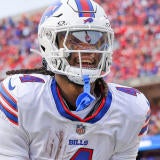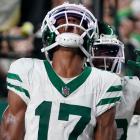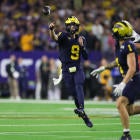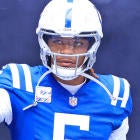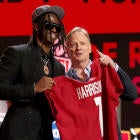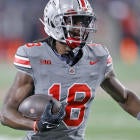
Doug Martin won't catch 49 passes like he did as a rookie, when he totaled over 1,900 yards from scrimmage and finished as the No. 3 Fantasy running back.
The Buccaneers drafted Charles Sims in the third round; they're talking him up as their passing-down back. Sims caught 70 passes as a freshman at Houston, 203 in his college career, while averaging over 10 yards per reception. He has soft hands, catching the ball easily away from his body, notes NFL.com.
Martin won't be a regular three-down back like he was in 2012. The question is how often he'll get spelled on first and second down by Mike James (4.9 ypc as a rookie last year), Bobby Rainey (150 carries, 5 rushing TDs last year) and Sims.
New offensive coordinator Jeff Tedford wants to give multiple running backs substantial carries, assuming he has the personnel to do so. He also has shown he'll ride one back if needed.
In eight of his 15 seasons running offenses at Oregon (1998-2001) and California (2002-12), Tedford's lead back received fewer than 60 percent of the carries, including six seasons with 52 percent or fewer. Scary numbers for Martin.
In the other seven years, the lead back got at least 69 percent of the totes. Tedford made it clear he prefers the first type of split.
"I think you have to alternate," Tedford told the Tampa Bay Times. "Even when we had two, 1,000-yard rushers [at California], J.J. Arrington was a 2,000-yard rusher and and we had a couple times when guys had a thousand yards apiece. But I don't believe that one back can carry the load. It's just too physical. I think you probably need to have two to three guys to bring different things to the table."
Here's the year-by-year breakdown, with the leading rusher and the percentage of RB carries he received (excludes runs by QBs and WRs):
Oregon, 1998: Reuben Droughns, 112 carries, 38 percent
Oregon, 1999: Droughns, 277 carries, 75 percent
Oregon, 2000: Maurice Morris, 260 carries, 77 percent
Oregon, 2001: Morris, 169 carries, 49 percent
California, 2002: Joe Igber, 241 carries, 79 percent
California, 2003: Adimchinobe Echemandu, 238 carries, 58 percent
California, 2004: J.J. Arrington, 289 carries, 69 percent
California, 2005: Marshawn Lynch, 196 carries, 51 percent (Justin Forsett got 132 carries)
California, 2006: Lynch, 223 carries, 59 percent (Forsett got 119 carries)
California, 2007: Forsett, 304 carries, 80 percent
California, 2008: Jahvid Best, 194 carries, 52 percent (Shane Vereen got 142 carries)
California, 2009: Vereen, 183 carries, 51 percent (Best got 141 carries)
California, 2010: Vereen, 231 carries, 70 percent
California, 2011: Isi Sofele, 252 carries, 70 percent
California, 2012: Sofele 146 carries, 44 percent (C.J. Anderson got 126 carries)
Whenever Tedford liked his secondary options, he got multiple running backs heavily involved. Martin -- who ran 319 times in 2012 and was on pace for 290 carries last year before his shoulder injury -- can expect no more than 250 carries despite the Bucs' run-first mindset.
Martin is falling slightly in early mock drafts. On average he's going 20th overall now. Jamey Eisenberg still rates him the No. 12 RB, while Dave Richard ranks him 14th at the position.
The Bucs' best all-around back by far, Martin is good enough to put up RB1 numbers with, say, 270 touches (240 carries, 30 catches), about 100 fewer than the 368 he got as a rookie. That's assuming he gets the goal-line work.
But the arrival of Tedford and Sims and the return of James and Rainey means you cannot count on Martin for RB1 production.







